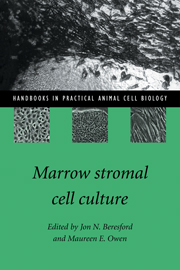Book contents
- Frontmatter
- Contents
- List of contributors
- Preface to the series
- Preface
- 1 The marrow stromal cell system
- 2 The bone marrow stroma in vivo: ontogeny, structure, cellular composition and changes in disease
- 3 Isolation, purification and in vitro manipulation of human bone marrow stromal precursor cells
- 4 Isolation and culture of human bone-derived cells
- 5 Marrow stromal adipocytes
- 6 Osteoblast lineage in experimental animals
- 7 Chondrocyte culture
- 8 Osteogenic potential of vascular pericytes
- Index
3 - Isolation, purification and in vitro manipulation of human bone marrow stromal precursor cells
Published online by Cambridge University Press: 20 January 2010
- Frontmatter
- Contents
- List of contributors
- Preface to the series
- Preface
- 1 The marrow stromal cell system
- 2 The bone marrow stroma in vivo: ontogeny, structure, cellular composition and changes in disease
- 3 Isolation, purification and in vitro manipulation of human bone marrow stromal precursor cells
- 4 Isolation and culture of human bone-derived cells
- 5 Marrow stromal adipocytes
- 6 Osteoblast lineage in experimental animals
- 7 Chondrocyte culture
- 8 Osteogenic potential of vascular pericytes
- Index
Summary
Introduction
Precursors of the marrow stromal system
The cell types comprising the stromal tissue of the bone marrow (BM) include reticular cells, smooth muscle cells, adipocytes, osteoblasts and various different populations of vascular endothelial cells (Lichtman, 1981; Tavassoli & Friedenstein, 1983; Dexter et al., 1984; Allen, Dexter & Simmons, 1990). A similarly diverse population of stromal cells develops in vitro when BM cells are explanted under appropriate conditions, as originally described by Dexter and colleagues. This well-documented heterogeneity of marrow stromal cells has complicated attempts to characterise the biological properties of each cellular component, a problem compounded by the paucity of monoclonal antibody reagents which might facilitate precise identification and isolation of each cell type.
Studies in rodents and humans have shown that the bone marrow stroma has the ability to regenerate either following physical disruption of the marrow cavity or following high dose chemotherapy or radiation (Patt & Maloney, 1975; Simmons et al., 1987; Testa, Hendry & Molineux, 1988). Given the heterogeneity of the stromal cell population within the bone marrow microenvironment (BMME), it is not known whether all of the different stromal cell lineages have the capacity for self-renewal or, alternatively, whether each stromal cell type arises from the proliferation and differentiation of a common stromal stem cell pool. Putative BM stromal precursor cells (SPC) have been identified in a number of species, including humans, by their ability to generate colonies of cells morphologically resembling fibroblasts when single cell suspensions of BM are explanted at appropriate densities in liquid culture (Fig. 3.1).
- Type
- Chapter
- Information
- Marrow Stromal Cell Culture , pp. 26 - 42Publisher: Cambridge University PressPrint publication year: 1998
- 17
- Cited by



